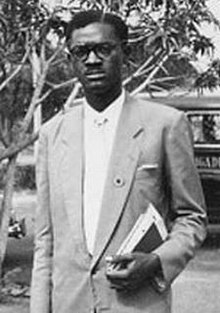Congolese National Movement
This article needs additional citations for verification. (July 2014) |
Congolese National Movement Movement National Congolais | |
|---|---|
| President | Patrice Lumumba |
| Founded | 1958 (first) 1990 (second) |
| Dissolved | 1965 (Original) |
| Succeeded by | Unified Lumumbist Party (not legal successor) |
| Headquarters | Kinshasa, Democratic Republic of the Congo |
| Ideology | Congolese nationalism Lumumbism Civic nationalism Federalism Tribalism |
| International affiliation | None |
| Colours | Blue, red, yellow |
| Party flag | |
 | |
 |
|---|
| United Nations Mission |
|
|
The Congolese National Movement (Template:Lang-fr, or MNC) is a political party in the Democratic Republic of the Congo.
History
Foundation

The MNC was founded in 1958 as an African nationalist party within the Belgian Congo. The party was a united front organization dedicated to achieving independence "within a reasonable" time and bringing together members from a variety of political backgrounds in order to achieve independence.[1] The MNC was created around a charter which was signed by, among others Patrice Lumumba, Cyrille Adoula and Joseph Iléo. Joseph Kasa-Vubu notably refused to sign, accusing the party of being too moderate.[2] By the end of 1959, it claimed to have 58,000 members.[3]
The MNC was a national party with substantial support in the whole of Congo, while most other parties were based primarily on tribal or ethnic allegiances and garnered support in their respective provinces.
The MNC was the biggest nationalist party in the Belgian Congo but had many different factions within it which took different stances on a number of issues and was increasingly polarized between moderate évolués and the more radical mass membership.[4] In July 1959, Iléo attempted to split the party and create a more radical party based on support of federalism rather than centralization, but his group failed to achieve mass defections from the main party.
As a result of the split, the remaining majority of the party took the name MNC-Lumumba (MNC-L) but the split also divided the MNC between the Lumumba-ists who held the Stanleyville region and its faction, which became the MNC-Kalonji (MNC-K; after Albert Kalonji who became its leader after his release from prison) which attracted support in Élisabethville (modern-day Lubumbashi) and among the Baluba ethnic groups.[5]
Both groups competed in the Congo's first parliamentary elections in June 1960, in which Lumumba's party emerged as the largest nationalist faction in the country. Lumumba formed a coalition with the more conservative and federalist ABAKO party led by Joseph Kasa-Vubu. Lumumba was elected Prime Minister, while Kasa-Vubu became Congo's first President.
Independence and the Congo Crisis

However, the country quickly plunged into the Congo Crisis, facing mutinies among the soldiers and separatism in Katanga (led by Moise Tshombe) and South Kasai (led by Albert Kalonji). In September, Lumumba and Kasa-Vubu fell out and Kasa-Vubu dismissed Lumumba and instead appointed Joseph Iléo, a member of the Kalonji party as prime minister. In turn, Lumumba declared the President deposed, while Iléo failed to gain parliamentary approval. The stalemate was ended when Lumumba's aide and partisan, Colonel Joseph Mobutu arrested Lumumba, who was later transported to Katanga and killed there under dubious circumstances.
MNC members remained a major players on different sides: Albert Kalonji remained in control of Kasai, in December Lumumba's deputy Antoine Gizenga formed another rebel government at Stanleyville and in February 1961 Iléo was again appointed prime minister at Léopoldville. In August, following protracted negotiations between all factions, Kasa-Vubu appointed the moderate Cyrille Adoula as prime minister and Gizenga to rejoined the central government. Relations soon broke down again and in January 1962, Gizenga was arrested. Adoula remained prime minister until 1964, when Kasa-Vubu appointed former separatist Moise Tshombe to the post to quell another revolt in the east.
In November 1965, following another fall-out between president and prime minister, Mobutu again seized power and under regime d'exception appointed himself President. Mobutu blamed the five years of turmoil on "the politicians" and decreed: "For five years, there will be no more political party activity in the country."
Ban
This meant the end of the MNC's legal activity until 1990 when, following the end of the Cold War and due to economic problems and domestic unrest, Mobutu agreed to lift the ban on other political parties and appointed a transitional government that would lead to promised elections.
Modern activities
Following the fall of Mobutu's one-man rule in Zaire, MNC-Lumumba was refounded. In 1992, it elected Patrice Lumumba's eldest son, François Lumumba, as their leader. Lumumba's heritage is also claimed by the Unified Lumumbist Party (PALU) led by Lumumba's former deputy, Antoine Gizenga, the former Prime Minister. Another of Lumumba's sons, Guy-Patrice Lumumba is also active in Congolese politics.
Notable members
- Cyrille Adoula
- Joseph Iléo
- Albert Kalonji
- Joseph Kasongo
- François Lumumba
- Patrice Lumumba
- Joseph-Desirée Mobutu
- Maurice Mpolo
- Joseph Okito
- Alphonse Songolo
References
- ^ Zeilig 2008, p. 64.
- ^ Zeilig 2008, pp. 64–5.
- ^ Zeilig 2008, p. 76.
- ^ Zeilig 2008, pp. 82–3.
- ^ Zeilig 2008, pp. 83–5.
Bibliography
- Zeilig, Leo (2008). Lumumba: Africa's Lost Leader. London: Haus. ISBN 9781905791026.
{{cite book}}: CS1 maint: ref duplicates default (link)
- 1950s establishments in the Belgian Congo
- 1960s disestablishments in the Democratic Republic of the Congo
- 1990s establishments in Zaire
- African and Black nationalist parties in Africa
- Congolese nationalism (Democratic Republic of the Congo)
- Political parties disestablished in 1965
- Political parties established in 1958
- Political parties established in 1990
- Political parties in the Democratic Republic of the Congo
